What does a meteor impact on Mars sound like? - NASA study
NASA's Mars seismometer has detected vibrations from four separate impacts over the last two years, now we can listen to them.
NASA's Mars InSight seismometer has detected vibrations from four separate impacts over the last two years. The study confirms that the crater and the seismic waves are indeed connected to one another.
A recording of the impact was released on NASA Jet Propulsion Laboratory's YouTube channel, and the unique sound is available for everyone to appreciate
Hear Meteoroid Striking Mars, Captured by NASA’s InSight Lander
In the new paper, published in the peer-reviewed academic journal Nature Geoscience, NASA detailed the impact of the meteorites hitting Mars. The first meteor entered Mars' atmosphere on September 5, 2021, and split into three shards that each left a crater.
NASA then sent their reconnaissance orbiter to the area in order to confirm the exact location of the impact craters. after the orbiter had located the spot of the impacts, it sent several pictures of the craters.
The pictures were made possible because of the High-Resolution Imaging Science Experiment camera, which provided NASA with color close-up shots of the craters.
Ingrid Dauber, a Mars impacts specialist and one of the co-authors of the paper said: "After three years of InSight waiting to detect an impact, those craters looked beautiful.”
“Impacts are the clocks of the solar system,” said the paper’s lead author, Raphael Garcia. “We need to know the impact rate today to estimate the age of different surfaces,” he added.
The number of craters is valuable information for scientists, as it indicates the age of the planet's surface, the more craters spotted, the older the surface.
NASA’s InSight lander
Researchers were able to confirm three other impacts, through the use of the NASA InSight lander. The vehicle has picked up seismic waves that were caused by the impacts. The InSight seismometer has detected over 1,300 marsquakes. This device is extremely sensitive and can detect seismic waves from thousands of miles away.
NASA’s InSight lander is expected to be operative for a few more months. Engineers predict that the vehicle should stop functioning between October of this year and January of next year.





No comments:
Post a Comment